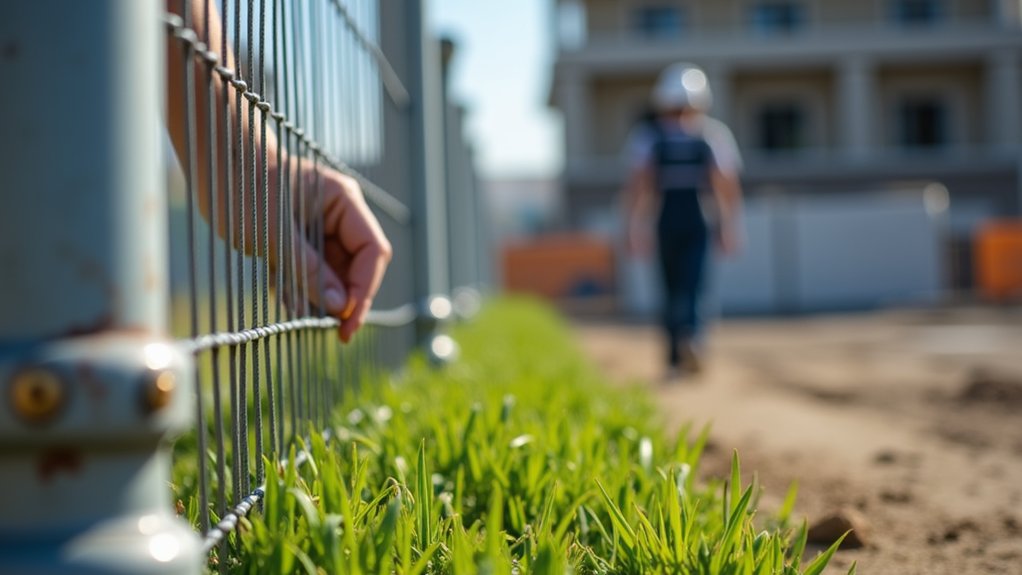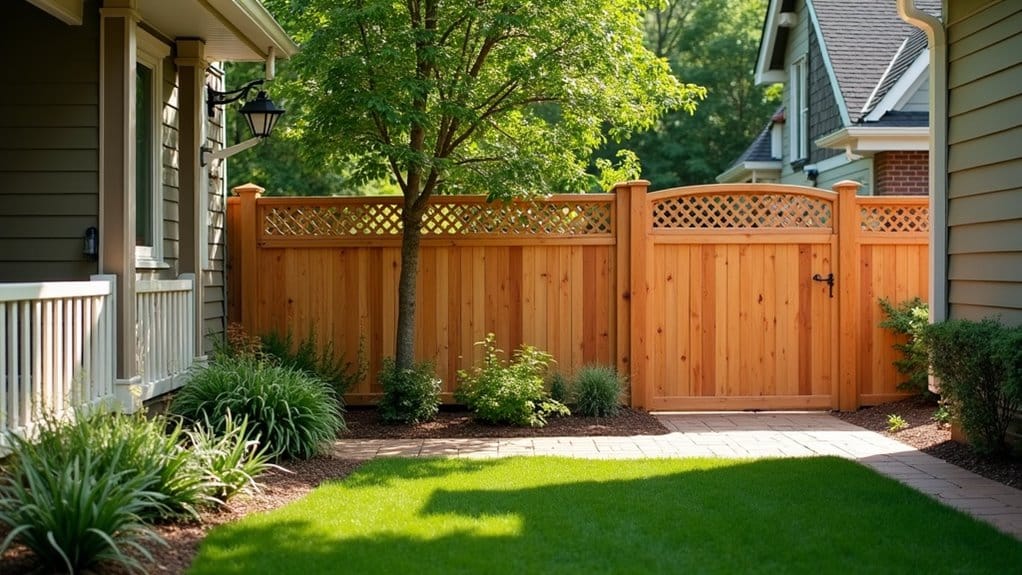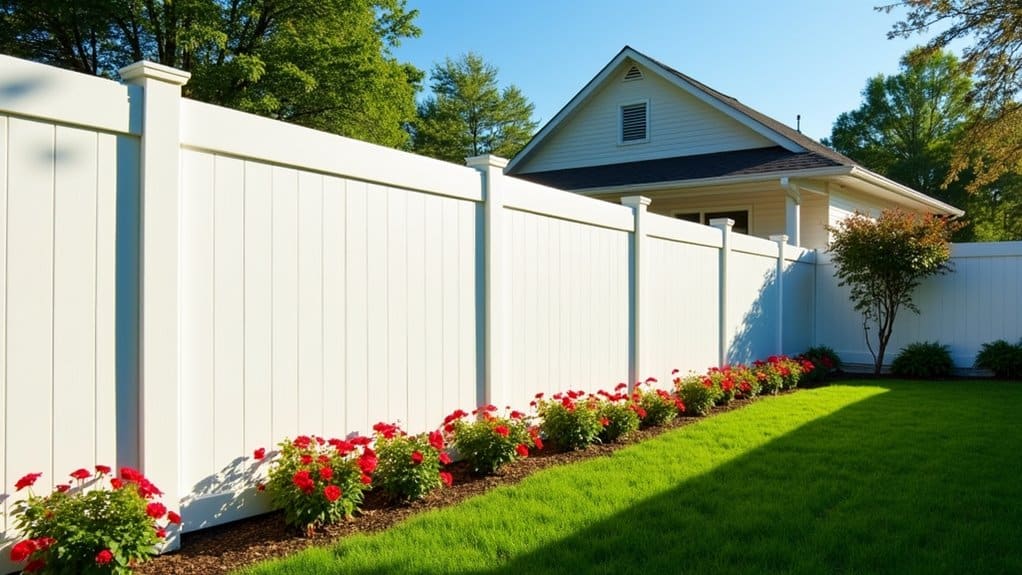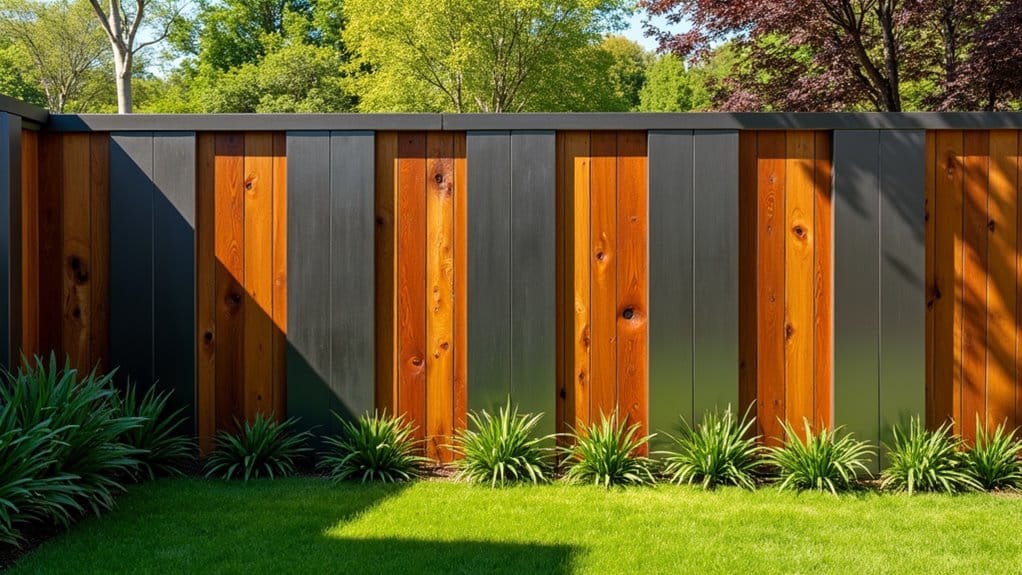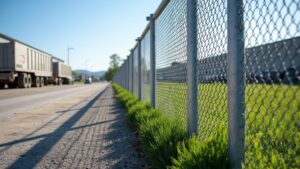To extend the life of temporary fencing, follow these simple steps. First, clean it regularly to avoid rust—just hose it down and scrub with mild soap, ensuring it dries well, especially at the bottom. When setting up the fence, prepare the site properly, mark the line clearly, and use corner posts for better alignment. Check for damage and loose connections routinely, fixing any issues right away. Adding security features can also boost protection. For more detailed tips and best practices, keep researching effective fencing maintenance.
Key Takeaways
- Clean the fence regularly with mild soap and a soft brush to avoid grime and rust.
- Inspect the fence seasonally to catch any issues early.
- Use sandbags or ground stakes for extra stability, especially on uneven ground.
- Tighten loose connections and fix minor damages right away to extend the fence’s life.
- Boost security with barbed wire, surveillance cameras, or motion sensors to keep trespassers out.
Cleaning and Rust Prevention
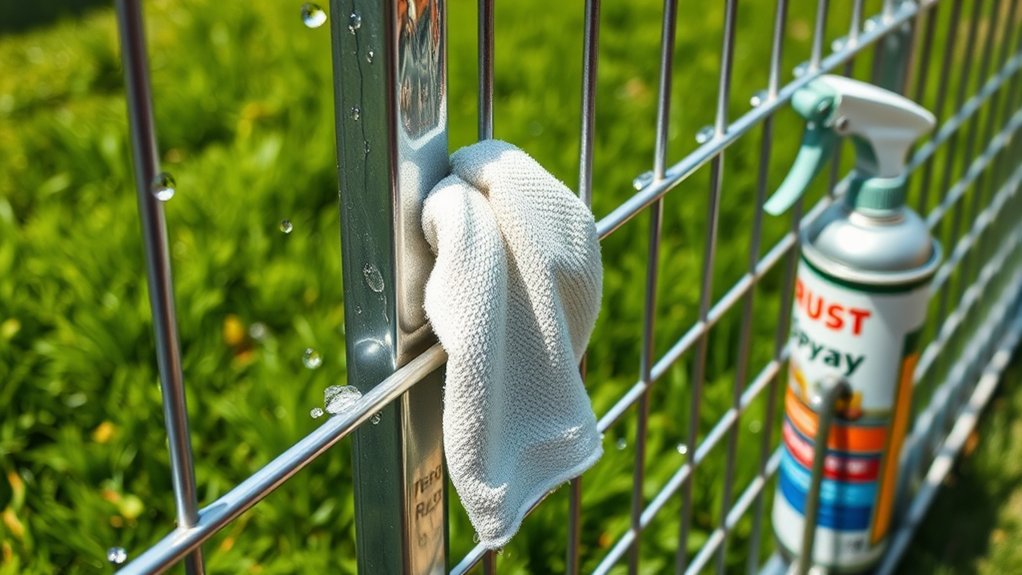
To keep your temporary fencing in good shape, regular cleaning and rust prevention are key.
Start by hosing down the fence from top to bottom. For tough grime, use a soft brush with mild soap, then rinse well. Be sure to dry off any excess water, especially at the bottom where rust can form. Regular maintenance can extend the lifespan of your fence significantly. Additionally, performing seasonal inspections can help identify potential issues before they escalate into major problems.
After cleaning, check for any damage or rust spots. Apply a protective coat to vulnerable areas and regularly inspect the fence.
Avoid harsh chemicals that could harm the fence’s finish. By cleaning and preventing rust effectively, your temporary fencing will stay strong and look great.
Installation Best Practices
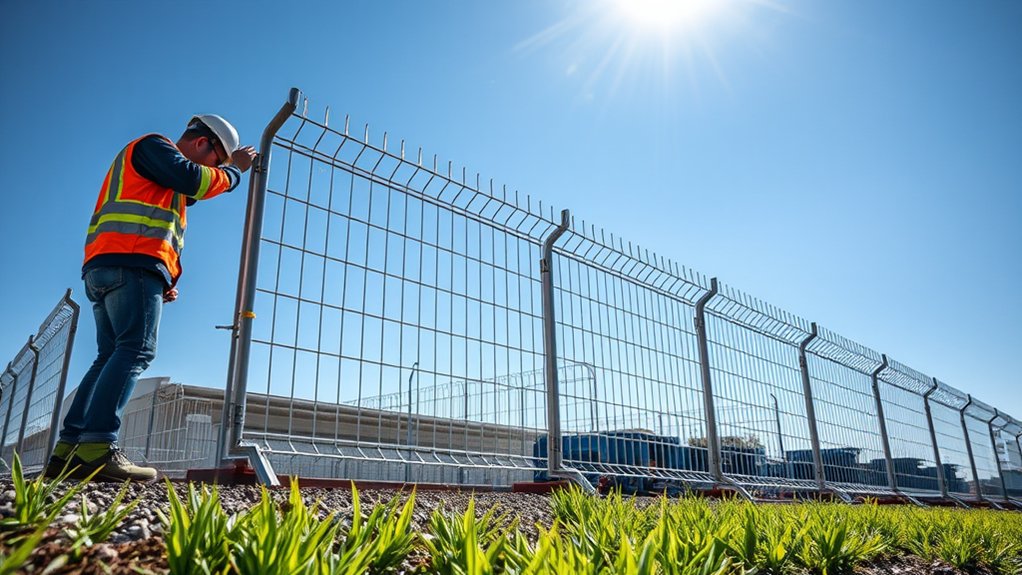
For a successful temporary fencing installation, start with proper site preparation. Clear debris and obstacles from the path to ensure a stable surface. Keep pathways wide for easy access, and move any obstructive equipment or materials. Clear the path for installation is essential to avoid complications during the setup process. It’s also beneficial to consider the local regulations regarding temporary fencing to ensure compliance.
Check the ground for stability and address any loose spots that could affect balance. Use flags or chalk to clearly mark the fence line. Gather all necessary materials and ensure your tools are in good working order. Begin with the corner posts to confirm alignment, then securely attach the panels, checking that all connections are tight.
For added stability, use sandbags or ground stakes, especially in uneven terrain. By tackling these installation challenges upfront, you’ll set up a reliable and durable temporary fence.
Regular Inspection and Maintenance
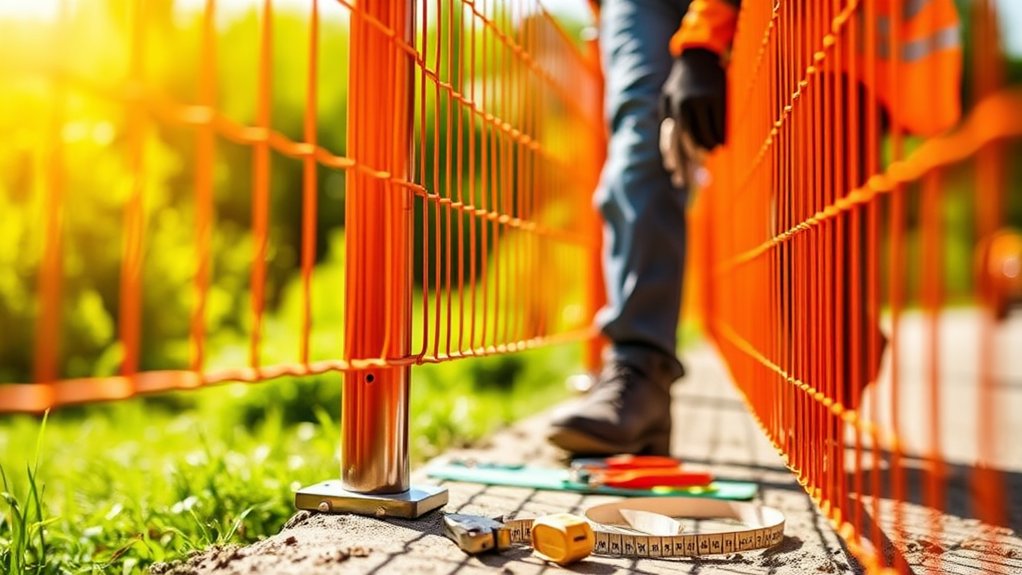
Regular inspection and maintenance are vital for the durability and effectiveness of temporary fencing. Establish a routine that includes daily checks for physical damage, leaning panels, and loose connections. Pay attention to environmental factors like mud, rust, and chemical runoff. Use a maintenance checklist to keep track of your findings. Schedule formal inspections weekly to comply with local regulations. Additionally, ensure that your fencing is anchored securely to enhance its wind resistance during adverse weather conditions. It’s also important to consider material longevity when assessing the condition of your fencing. Clean your fencing every two weeks or after exposure to contaminants, using a garden hose and detergent as needed. After severe weather, inspect for damage and remove debris to ensure stability. Following this maintenance plan will help extend the life of your temporary fencing.
Security Enhancements
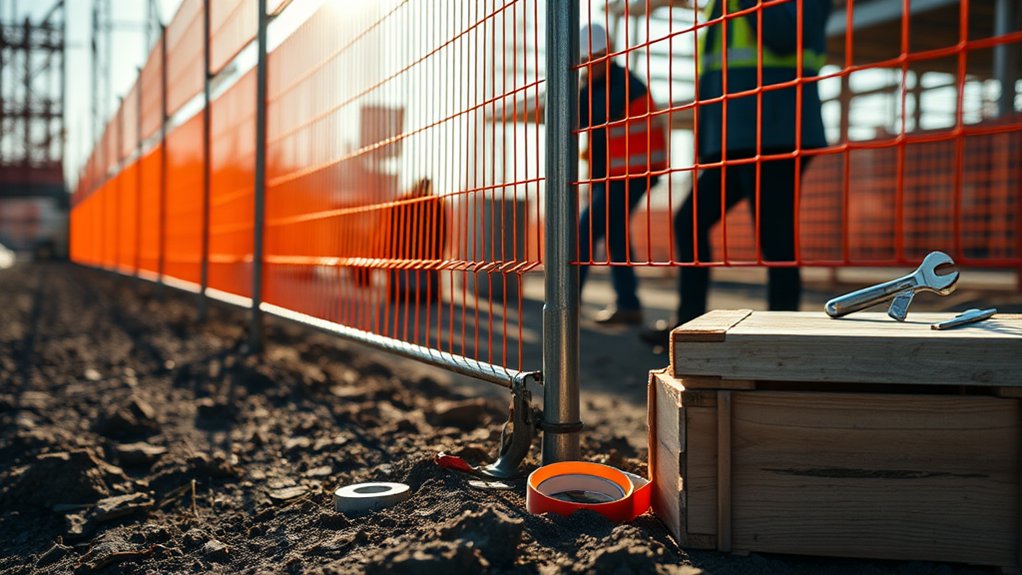
To boost the security of your temporary fencing, add features like barbed wire and secure gates to deter unauthorized access.
Regularly upgrade materials to ensure your fencing withstands weather and potential breaches.
These enhancements not only strengthen security but also improve the overall integrity of your site.
Deterrent Features Integration
Temporary fencing is a basic barrier, but adding deterrent features significantly boosts security.
For instance, using tightly spaced panels and anti-climb materials makes it harder for intruders to gain access. Alarm systems and motion sensors can alert you instantly if someone tries to breach the fence.
Surveillance cameras offer continuous monitoring, while smart technology allows for remote management and quick notifications.
Strengthening your fence with durable materials and clear signage serves as a strong psychological deterrent.
Together, these elements create a comprehensive security system to protect your site from intruders, vandals, and thieves.
Secure Gate Mechanisms
To ensure strong security at your site with secure gate mechanisms, start with gates that have specialized hinges for smooth access and secure closure.
Use reliable locking systems to prevent unauthorized entry and enhance access control.
Opt for gates made from durable materials like steel or aluminum to resist environmental wear.
Regular maintenance is key; routinely check hinges and locks to keep them clear of debris and functioning well.
Adding anti-tamper features and locking mechanisms can further boost security.
Finally, keep a record of your maintenance activities to monitor performance and ensure compliance with safety standards.
Material Upgrades Assessment
To enhance the security of your temporary fencing, start by choosing strong materials like steel or aluminum panels. These options offer excellent strength and rigidity.
Assess durability for materials like chain link or welded wire mesh, ensuring they resist rust and last longer. Adding barbed wire can help deter unauthorized access, and using heavier gauge steel boosts strength.
For stability, consider concrete block stabilizers at the base to withstand wind and impact. If you opt for plastic materials, choose UV-resistant types to avoid degradation.
Lastly, smaller mesh openings make it harder for tools to breach the fence. Upgrading your materials not only improves security but also ensures your fencing remains intact over time.
Safety Considerations
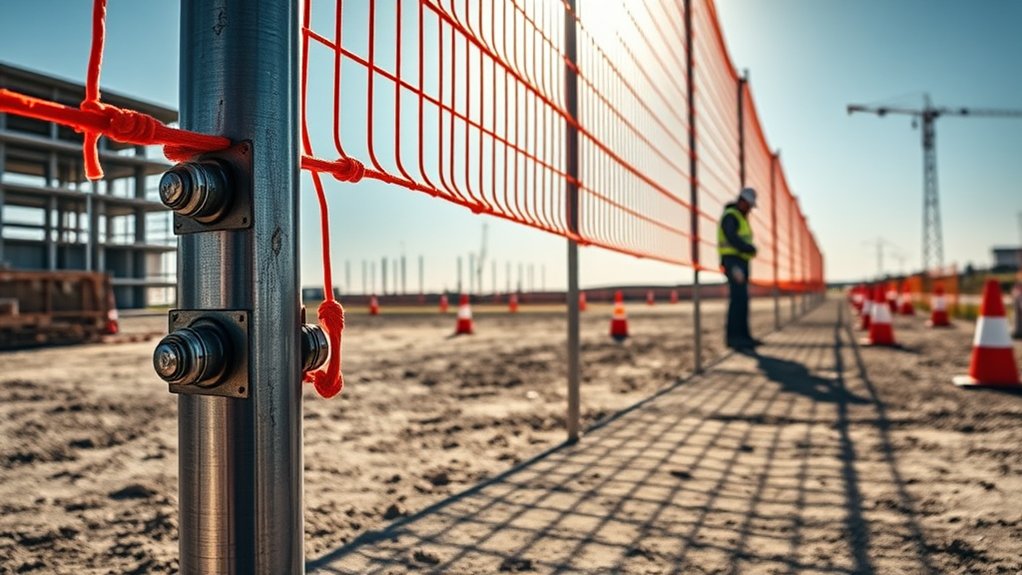
When maintaining temporary fencing, it’s crucial to ensure visibility and proper signage for safety.
Install clear signs to mark restricted areas and hazards.
Keep the perimeter clear of debris to avoid trip hazards and ensure safe access for everyone.
Visibility and Signage
Clear visibility and effective signage are crucial for safety around temporary fencing. Place signs properly, using large, easy-to-read text and high-contrast colors. Regularly check and replace any faded or damaged signs to ensure compliance with local regulations.
| Visibility Enhancement | Key Practices |
|---|---|
| Use high-contrast colors | Boost visibility during the day |
| Add reflective strips | Enhance visibility at night |
| Position signs at eye level | Ensure easy viewing |
| Use durable materials | Prolong sign lifespan |
| Conduct regular inspections | Keep signs legible and effective |
Trip Hazards Prevention
Trip hazards around temporary fencing can lead to serious accidents, so it’s crucial to take preventive steps.
First, identify trip hazards by ensuring fence bases are low-profile and clearly visible. Instead of sandbags, use cinder blocks or specialized anchor blocks for better stability.
Regularly check these bases and keep them free of debris to reduce tripping risks. Establish a routine cleanup schedule to maintain a safe environment.
Configure fences with secure panels and controlled access points to further minimize hazards. Train staff to quickly report any debris, and use caution tape in busy areas.
Longevity Optimization
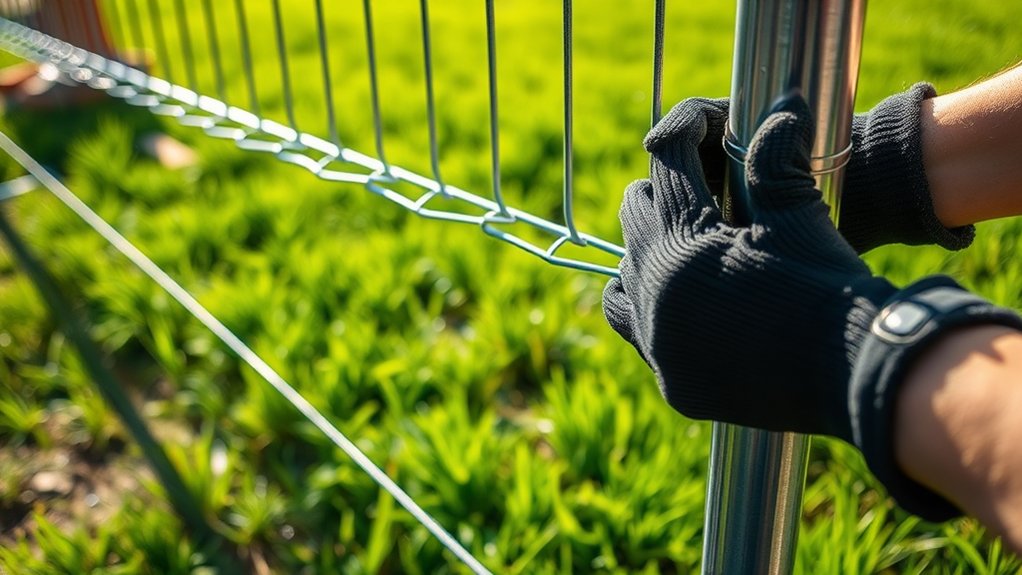
To ensure your temporary fencing lasts longer, combine hardware upgrades, structural reinforcements, and protective measures. Here are some effective strategies:
| Aspect | Recommendation | Benefits |
|---|---|---|
| Hardware Upgrades | Use corrosion-resistant fasteners | Prevents rust; lifespan increase of 15-20 years |
| Structural Reinforcements | Install diagonal bracing | Boosts stability; adds 5-10 years of life |
| Protective Measures | Use post caps on wood fences | Reduces water damage and UV exposure |
Implementing these practices can significantly enhance the durability of your fencing.
Frequently Asked Questions
How Often Should I Inspect My Temporary Fencing?
Inspect your temporary fencing weekly for structural integrity and stability. After severe weather or events, perform additional checks. Regular inspections help ensure safety and effective maintenance.
What Materials Are Best for Temporary Fencing?
For temporary fencing, chain link is a strong and visible option, perfect for construction sites. Wood panels are budget-friendly and easy to set up, but they need regular upkeep. Choose based on your project’s security and visibility requirements.
Can Temporary Fencing Be Reused After Removal?
Yes, temporary fencing can be reused after removal. To maximize its lifespan, focus on proper disassembly and storage. For example, take care when taking down the panels to avoid damage, and store them in a dry, organized space. This approach keeps the fencing functional and cost-effective for future use.
How Do I Properly Store Temporary Fencing?
To store temporary fencing properly, use stackable stillages or racks to keep everything organized. This prevents damage, saves space, and makes it easy to access the panels when you need them.
What Are Common Signs of Temporary Fence Damage?
When checking for fence damage, look for holes, tears, rust, or warping. Regular inspections help catch problems early, which is crucial for timely repairs and keeping your fence secure and functional.
Conclusion
To extend the life of your temporary fencing, focus on three key areas: cleaning, secure installation, and regular inspections. For example, a quick wash can prevent rust and dirt buildup, while ensuring the fencing is properly installed helps it withstand harsh weather. By regularly checking for damage, you can catch issues early and avoid costly replacements. With a bit of maintenance, you can turn what seems like a short-term solution into a durable asset that saves you time and money.

